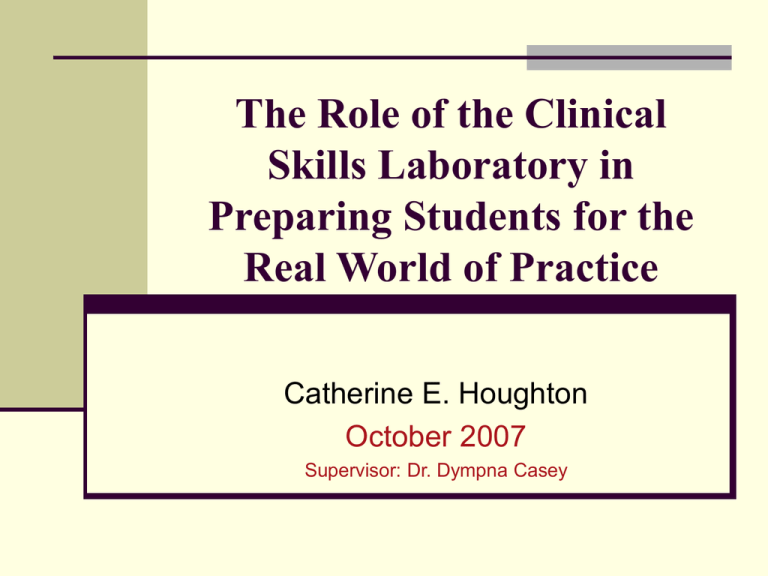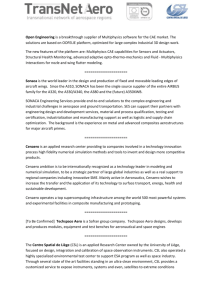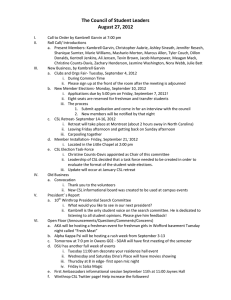The Role of the Clinical Skills Laboratory in Preparing Students for the
advertisement

The Role of the Clinical Skills Laboratory in Preparing Students for the Real World of Practice Catherine E. Houghton October 2007 Supervisor: Dr. Dympna Casey Aim of the Presentation Exploration of previous research Aim of the research in progress Interpretivism Case study design Challenges Changes in Nurse Education emphasis on theory/decreased emphasis in skills learning In clinical setting: More rapid patient turnover Increased high dependency patients Shortage of qualified practitioners “physical structure” supporting the new “academic structure” How does the CSL facilitate this statement? During the course of their education, students are expected to acquire knowledge, incorporate critical thinking and psychomotor skills, develop self-confidence in their abilities, and then transfer this knowledge to the clinical setting (Childs and Sepples, 2006) The Function of the CSL Simulated Learning Simulated Models Standardised Patients Computer-based Simulation Audio Visual Recording Skills assessment (i.e. OSCE) Simulated Models Low-fidelity Moderate fidelity High Fidelity Standardised Patients Coached to present a patient problem accurately Increased levels of judgement, performance and communication skills Same outcome as real patients ? Reliability of SP feedback Computer based Simulation Higher Satisfaction and self-efficacy ? Improve ability to demonstrate skill Penfield Virtual Hospital Authentic World Audio-Visual Recording Benefits Immediate Analysis and Feedback Recognise own mistakes Distracting, anxiety, behaviour modification OSCE (Objective Structured Clinical Examination) Positive Feedback and reflection Motivation to learn Dependent on assessors’ subjectivity Cause of Anxiety Benefits of CSL Teaching Gain confidence Motivation to learn Student Satisfaction Safe environment to practice skills Patient Safety Communication Skills Interprofessional Learning Improvement on traditional methods Disadvantages of CSL Teaching Student Anxiety Comparison with reality of clinical setting Needs context ? Learning opportunities in clinical area ? Learn non-evidence based methods Methodological Issues Qualitative Quantitative Triangulation Total Nursing Research 9 18 1 28 Medical Research 1 15 1 17 Medical & Nursing Research 1 1 1 3 Other Health Professionals 0 2 0 2 Total 11 25 3 50 Methodological Issues Criticism of the primarily positivist approach ? use of OSCE to determine the effectiveness of CSL teaching Level of education Research Aims To analyse the teaching strategies used in Irish Clinical Skills Laboratories To investigate the factors which influence how student nurses use their learned skills in the practice setting. To examine student nurses’ perceptions of the methods used to teach clinical skills in the laboratory. To explore qualified clinical and CSL staff’s perceptions of undergraduate clinical skills teaching. Research Process Phase 1 Visit all the 13 Nursing Centres Criteria for Selection of 4 Sites Gain Access Phase 2 Pilot phase Phase 3 Data Collection observation, interviews, documentary sources Phase 4 Cross-case/Within Case Analysis Interpretivist Paradigm Nature of the world as it exists Subjectivity Multiple realities Emic and Etic perspective Multiple Case Study Research Natural context Exploratory Emic Embedded Perspective Instrumental Flexibility Multiple Challenges Gaining Access Ethical Issues Semesters/Timetables Thank You Catherine Houghton catherine.houghton@nuigalway.ie Department of Nursing and Midwifery Studies Aras Moyola NUI Galway Ireland


